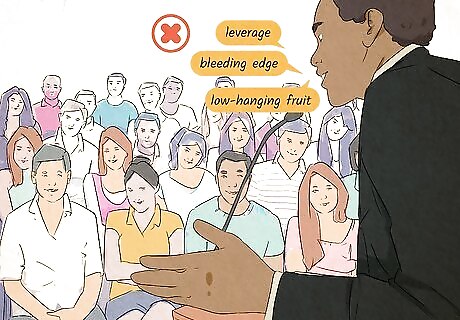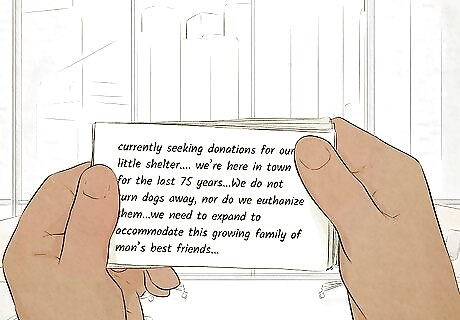
views
Being Confident in Conversations and Presentations

Make eye contact. Making eye contact with those you are speaking to shows respect and helps maintain attention. If you are speaking to a crowd, try looking to their foreheads if direct eye contact makes you uncomfortable.

Maintain good posture. Back straight, head up but relaxed is a good way to show confidence. If you feel better, you will communicate with more confidence.

Avoid nervous movements or "adjustments." These telegraph your nervousness. Constantly adjusting your clothes, for instance, is distracting to a listener or someone speaking directly to you. Relax and listen to what the other person is saying.

Avoid filler words. Often when people speak, their sentences are peppered with filler words like "um," "like," "I mean," "you know," and so on. This can be out of habit, or a way for the person to buy time as they think of what they are going to say. No matter the reason, this can make you come off a hesitant and unsure. Instead of saying "Umm..." next time you need a second to collect your thoughts, just allow yourself to be silent for a moment. It may feel awkward at first, but you'll appear more like you're carefully choosing your words than panicking because you don't know what to say.

Smile. A confident smile (even if you might not feel it inside) will project confidence to those around you. The added benefit is that it will make you start to feel better and less nervous as well.

Look the other person in the eye. This shows your own confidence. Even if you don't feel assertive, eye contact can be a great way to also gauge how your conversation is going. Project confidence, and you will start to feel it.
Using Assertive Communication

Identify and communicate your needs and wants. Be clear about what you are asking the other person. Whether it's your spouse or your boss, sometimes we just don't tell them exactly what we are thinking. To be more assertive, tell people in a polite yet honest way what you need from them. For example, you may say, "I know it's convenient for me to be available over email during weekends, but I can't do that any more. I need time with my family. I hope you understand that I need to focus on them during those days." You may also say, "I'm feeling overwhelmed by cooking dinner every night after coming home from work. Could you choose two nights that you would be willing to take over dinner every week?" Another example dialogue might be, "I'm really sorry, but I won't be able to volunteer at school this year. I got a new position at work and am working much longer hours."

Stand up for yourself. It's terrible to feel attacked in conversation, but there are steps you can take to turn the tables. You should be assertive without being aggressive and try to move the conversation into a more productive area. Try using “I” statements to help become more assertive. For example, you may say, "I disagree that this is a bad idea," "I feel you're being too negative about this," or "I believe this can work."

Try fogging. This technique helps to defuse negative and aggressive conversations. You turn part of the criticism back onto yourself (essentially agreeing with some of the other person's characterization of you) and show concern for them. For example, your coworker may say, "You missed the project meeting and don't have any way to make it up. I am seriously considering moving you back to the packing department.” You may then respond by saying, “I realize I missed the meeting because of poor time management on my part. I knew you would be upset.”

Become a broken record. Sometimes, a situation might call for constant repetition of your problem. This often seems to be the case when dealing with customer service, either on the phone or in person. The broken record technique can help you keep the conversation focused the way you want it to be. For example, a customer may say to you, “This fan worked for one day and broke. I need a replacement.” You may then respond, “I'm so sorry, but our sales are final," or “Once an item leaves the store, we can't guarantee how you'll use it so we can't get you a new one." If the customer continues to get upset, you may calmly say, “Let me get the manager to explain it to you.”

Use a “Thanks, but no” construction to stand your ground. If someone is trying to get you to do something you don't want to do, stand up for yourself. For example, you may say, "Thanks, but I don't want to go have a drink with you," "Thanks for telling me, but I still don't agree with you," or "Thanks, but I just don't think that I am comfortable with that."
Getting Your Points Across

Be clear. Make the points you want to convey strongly and without going off on tangents. Start with your main point -- don't bury it. Use carefully chosen words to make your point.

Choose your words carefully. Make strong points. Avoid words like “could” or “perhaps.” Use strong declarative sentences -- these show confidence in yourself and your ideas.

Know your audience. Make sure that the vocabulary you use is appropriate for the people who will be listening or reading your work. Don't use complicated words for elementary school students, and don't shy away from complexity for college students, for example.

Avoid jargon. Don't assume everyone will know what you're talking about if you use the vocabulary of a particular subject or job. If you're using such vocabulary, explain it the first time for your audience so they can understand.
Speaking in Public

Write your remarks beforehand. Some people are very comfortable speaking without any guide in front of them, but that often takes a lot of practice. To communicate with confidence, you need to feel comfortable with your material, and that often requires thought beforehand. Write down what you're going to say.

Practice. Before you get in front of an audience, say your remarks to yourself. Once you've read through them and are comfortable, do it for a family member or friend. Ask for help conveying confidence, and any other suggestions they might have to make your presentation better.

Take the text of the speech or make notes. Decide if you want to have the full text in front of you, or if you'd rather use notecards to make your presentation. Some people might even want to memorize their remarks, but this takes a great deal of practice (and the foreknowledge that you won't freeze up and forget it in front of people). It's probably best to not go up without any papers or cards -- you need something that can help you get back on track if you're nervous.
Expressing Yourself in Writing

Demonstrate your command of the material. If you're writing a paper, show your knowledge of the relevant information and then how your work fits into it. Mention the authors that you've been working from to acknowledge their contribution, and that you're building on what they have done.

Present strong evidence. After you have made your point, write clearly about the evidence that backs it up. Explain why you are confident in the evidence you have found -- you might want to detail how you did your research.

Cite your information. Part of communicating with confidence is giving credit where credit is due. If your ideas and evidence are from another person's work, make sure to cite them.




















Comments
0 comment